► Carbonfibre-tubbed two-seat 33 Stradale
► Choice of twin-turbo V6 or electric power
► Limited edition of 33, priced above €1m
The recipe for the new Alfa Romeo 33 Stradale supercar involves a lot of history, some remarkable numbers and a healthy pinch of madness – not something we’re used to from Stellantis, the vast car-making empire born in 2021 with the merger of Fiat Chrysler Automobiles and the French PSA Group.
Lancia and Maserati can claim iconic status, but of the Stellantis brands surely only Alfa Romeo could hope to build 33 examples of new carbon-tubbed two-seat supercar, available with either battery-electric or twin-turbo V6 power, and price them in excess of €1m each.
Any why not? This is Alfa Romeo. The Alfa Romeo that dominated inter-war Grand Prix racing. The Alfa Romeo that flat-out steamrollered the first two years of Formula 1. The Alfa Romeo that has since managed to hit breathtaking high notes with just enough regularity to maintain a reputation for soul-stirring automotive alchemy.
It’s hard to know which is the more impressive achievement: getting the idea green-lit by Stellantis’ infamously spending-averse big cheese Carlos Tavares; or selling all 33 cars before most of this planet’s eight billion souls knew it existed.
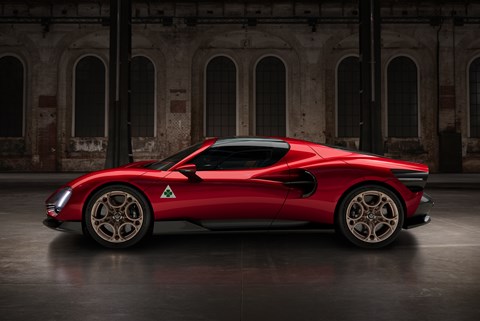
Scooped by CAR back in 2022, the new 33 Stradale exists because Jean-Philippe Imparato is in charge. A passionate car guy with an all-consuming love of the brand he steers, Imparato has long schemed to create an Alfa worthy of both the brand’s most ardent fans and its extraordinary heritage, one that still manages to run Ferrari close for racing glory, design back catalogue and that magical art-meets-science-becomes-kinetic-sculpture thing with which industrial Italy’s elite are rightly synonymous.
‘We are working on something you could put beside the 8C in our museum,’ Imparato told CAR a couple of years ago – yes, with a glint in his eye. ‘The car will be sold out before I unveil it, that’s absolutely sure. So, if I don’t make it, I’ll have to give back the down-payments!’
That you’re reading this suggests Imparato hasn’t had to make any awkward bank transfers. Here’s how he’s taken Alfa back to the top table.
Step one: reboot one of the prettiest cars ever built
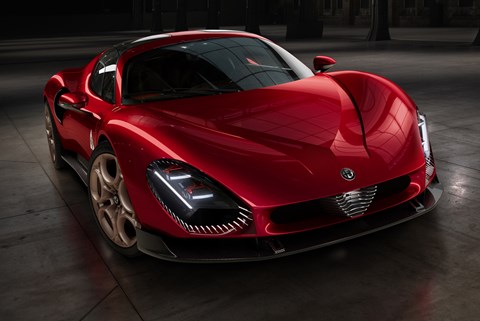
Alfa is entirely unapologetic about its inspiration on this one – the 1967 33 Stradale. The logic is solid. Why risk missing the mark when you can, like Lamborghini with its remade Countach, Ford with the GT(s) and Ferrari with its vaguely P4-inspired SP3 Daytona, simply re-release your Nirvana Nevermind equivalent, remixed and remastered for a different, altogether colder age?
That the source material is spectacular is beyond doubt. Riding the wave of optimistic creativity and economic growth that swept through Europe in the ’60,s and keen to reprise the world-beating motorsport glories of the past, the original 33 Stradale began with Alfa’s acquisition of Autodelta, its motorsport partner. The race outfit was relocated closer to the factory and the Balocco test track, and by ’65, inspired by aeronautical engineering, it had created the Tipo 33, the machine that would underpin the Stradale a couple of years later.
With an H-shaped chassis of aluminium tubes with integral fuel tanks and a gorgeous little 2.0-litre V8 tucked behind the pilot, the 33 racer was lightweight in the extreme (600kg, the regulatory minimum), with a flyweight front subframe in magnesium and fibreglass bodywork. The engine and gearbox were mid-mounted, longitudinally. That powertrain evolved first into a 3.0-litre V8 (the Targa Florio winning 1970 Tipo 33/3) and then the all-conquering 12-cylinder boxer endurance racers of the mid-’70s; the TT 12 (500bhp) and the twin-turbo SC 12 Turbo (circa 640bhp), constructors’ world champions both. (That same boxer 12 engine would also see the Alfa name back in F1 for the first time since Farina and Fangio’s reign in ’50 and ’51, in the back of Gordon Murray’s Martini-liveried Brabham BT-45.)
As Tipo 33s fired up the Alfa legend on track, so its chassis (aluminium subbed for steel) also helped make Alfa synonymous with pioneering design. It underpinned a series of outrageous creations, the most startling of which were the 33 Stradale and the Carabo, a prime exponent of wedge-shaped futurism conceived by Bertone’s Marcello Gandini.
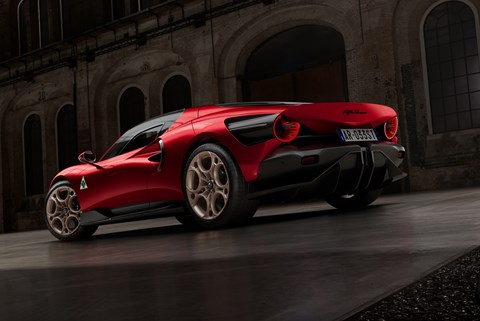
Designed by Franco Scaglione, the compact 33 Stradale wore its competition-bred origins with pride. Rendered impossibly desirable by its competition pedigree, startling performance and luminously beautiful sheet metalwork, the 33 Stradale was unveiled at the ’67 Turin motor show with a price to match – a then sobering 10 million lire.
The new 33 Stradale avoids slavishly updating the original but instead selectively borrows sufficient cues to make the source material obvious. Pretty from the front and almost brutal aft of the jet fighter-like bubble cockpit, all the Alfa cues are present and correct, from the shield through the V-shaped bonnet graphic to the telephone-dial wheels.
Taken as a whole it understandably lacks both the original’s impossible purity and its outlandishly compact dimensions, but does a fine job of updating its essence for our more complex, less artistic age.
Step two: limit volume and set the price sky high
33 units is punchy. But it’s also exactly where a car like this needs to be. Everyone wants something unique, and if you can’t have unique then just 33 globally is the next best thing.
To put that into context, Ferrari pre-sold 599 examples of the comparable (SP3 Daytona, having gone into bat with a base price of £1.7m. Lamborghini sold 63 Sian coupes and 19 roadsters at £2.5m plus taxes before rebodying the same car as the Countach and cranking out a further 112 at £2m plus tax.
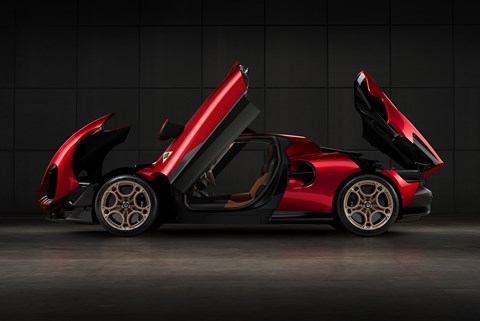
Alfa has founded a new department: Bottega, Italian for ‘workshop’, which will create the cars in cahoots with their owners. The construction will take place at Carrozzeria Touring Superleggera starting next summer, with first deliveries in December 2024, and all 33 will be left-hand drive.
Paint options are Rosso Alfa, royal blue, a tinted clear-coat red and a racing-inspired red and white livery. Elements of the car (wheels, air intakes, front shield) offer scope for creativity, with owners invited to work with Alfa to hone their final designs, their efforts observed by the 33 Committee (with the CEO as its chairman, no less) to ensure nothing too gauche/outlandish/naff sneaks through to sully the 33 legend.
Step three: riff on the original’s race-ready underpinnings
Buyers can choose one of two powertrains. One comprises a 3.0-litre twin-turbo V6, mounted sideways, making in excess of 620bhp (and described as ‘an evolution of the [2.9-litre] V6 already fitted to the Italian brand’s highest-performance cars’), driving the rear wheels via an eight-speed twin-clutch transmission and a limited-slip differential.
The other is battery electric. Beyond a 740bhp peak power output and an estimated range of 280 miles, details are scant, though three e-motors – two on the rear axle and one on the front, like the Maserati MC20 Folgore due next year – is likely. Top speed is a neat 333km/h (a less neat but still impressive 207mph), with 0-62mph coming up in ‘under 3.0 seconds’. Fast enough, then.
At its core the 33 Stradale combines aluminium subframes with a big-money carbonfibre monocoque.
That Maserati already has one, designed around a V6 engine (albeit a different one) and ready to accept battery-electric power is also no coincidence.
Suspension is double-wishbone front and rear, with adaptive damping and a nose lift. Braking is by-wire and runs Brembo carbon-ceramics.
Step four: craft a work-of-art interior
Everything is up for grabs in terms of cockpit spec, though Alfa’s offering two main themes: classic Tributo in aluminium and leather (two-tone biscuit and slate); and racier Alfa Corse, with its carbonfibre and alcantara finishes.
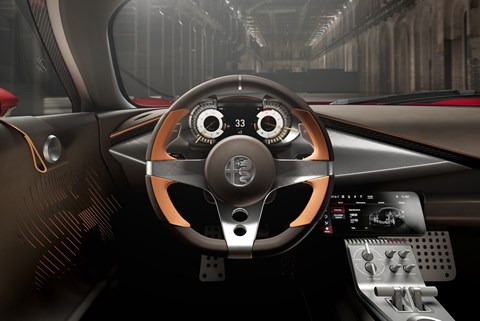
Climb in and it’s a suitably special cockpit, with extensive glazing and a refreshingly button-free steering wheel backed by two large aluminium shift paddles. That uncluttered theme continues with hidden air vents and chunky mechanical controls in cool aluminium on the central tunnel.
Switches on the central tunnel let you toggle the more compliant Strada or full-bore Pista drive modes, and ESC completely off is an option. There’s also launch control and, sensibly, the ability to combine Pista everything with Strada’s suspension settings.
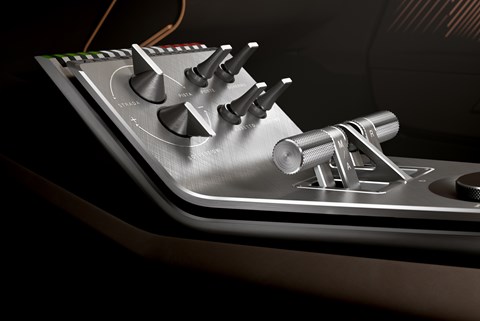
Step five: hint at more to come
Getting too excited about Alfa’s prospects is a risky business. We’ve learned that the hard way. But the new 33 Stradale looks an awful lot like cause for optimism, as does Imparato’s assertion that Alfa’s heartstring-plucking ambitions don’t begin and end here.
‘This is the brand’s first fuoriserie [custom-built] car since 1969, and I promise it won’t be the last,’ he says. And what a back catalogue there is to go at.